Cannabidiol protects against hepatic ischemia/reperfusion injury by attenuating inflammatory signaling and response, oxidative/nitrative stress, and cell death
- PMID: 21362471
- PMCID: PMC3081988
- DOI: 10.1016/j.freeradbiomed.2011.02.021
Cannabidiol protects against hepatic ischemia/reperfusion injury by attenuating inflammatory signaling and response, oxidative/nitrative stress, and cell death
Abstract
Ischemia/reperfusion (I/R) is a pivotal mechanism of liver damage after liver transplantation or hepatic surgery. We have investigated the effects of cannabidiol (CBD), the nonpsychotropic constituent of marijuana, in a mouse model of hepatic I/R injury. I/R triggered time-dependent increases/changes in markers of liver injury (serum transaminases), hepatic oxidative/nitrative stress (4-hydroxy-2-nonenal, nitrotyrosine content/staining, and gp91phox and inducible nitric oxide synthase mRNA), mitochondrial dysfunction (decreased complex I activity), inflammation (tumor necrosis factor α (TNF-α), cyclooxygenase 2, macrophage inflammatory protein-1α/2, intercellular adhesion molecule 1 mRNA levels; tissue neutrophil infiltration; nuclear factor κB (NF-κB) activation), stress signaling (p38MAPK and JNK), and cell death (DNA fragmentation, PARP activity, and TUNEL). CBD significantly reduced the extent of liver inflammation, oxidative/nitrative stress, and cell death and also attenuated the bacterial endotoxin-triggered NF-κB activation and TNF-α production in isolated Kupffer cells, likewise the adhesion molecule expression in primary human liver sinusoidal endothelial cells stimulated with TNF-α and attachment of human neutrophils to the activated endothelium. These protective effects were preserved in CB2 knockout mice and were not prevented by CB1/2 antagonists in vitro. Thus, CBD may represent a novel, protective strategy against I/R injury by attenuating key inflammatory pathways and oxidative/nitrative tissue injury, independent of classical CB1/2 receptors.
Published by Elsevier Inc.
Conflict of interest statement
Figures
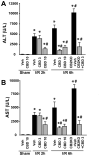




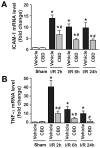

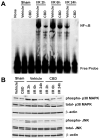
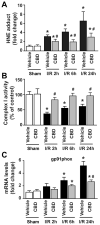



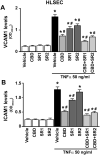

Similar articles
-
A new cannabinoid CB2 receptor agonist HU-910 attenuates oxidative stress, inflammation and cell death associated with hepatic ischaemia/reperfusion injury.Br J Pharmacol. 2012 Apr;165(8):2462-78. doi: 10.1111/j.1476-5381.2011.01381.x. Br J Pharmacol. 2012. PMID: 21449982 Free PMC article.
-
Cannabidiol attenuates cardiac dysfunction, oxidative stress, fibrosis, and inflammatory and cell death signaling pathways in diabetic cardiomyopathy.J Am Coll Cardiol. 2010 Dec 14;56(25):2115-25. doi: 10.1016/j.jacc.2010.07.033. J Am Coll Cardiol. 2010. PMID: 21144973 Free PMC article.
-
Cannabidiol Protects against Doxorubicin-Induced Cardiomyopathy by Modulating Mitochondrial Function and Biogenesis.Mol Med. 2015 Jan 6;21(1):38-45. doi: 10.2119/molmed.2014.00261. Mol Med. 2015. PMID: 25569804 Free PMC article.
-
Cannabinoid-2 receptor agonist HU-308 protects against hepatic ischemia/reperfusion injury by attenuating oxidative stress, inflammatory response, and apoptosis.J Leukoc Biol. 2007 Dec;82(6):1382-9. doi: 10.1189/jlb.0307180. Epub 2007 Jul 25. J Leukoc Biol. 2007. PMID: 17652447 Free PMC article.
-
Cannabidiol as an emergent therapeutic strategy for lessening the impact of inflammation on oxidative stress.Free Radic Biol Med. 2011 Sep 1;51(5):1054-61. doi: 10.1016/j.freeradbiomed.2011.01.007. Epub 2011 Jan 14. Free Radic Biol Med. 2011. PMID: 21238581 Free PMC article. Review.
Cited by
-
Cannabidiol-Driven Alterations to Inflammatory Protein Landscape of Lipopolysaccharide-Activated Macrophages In Vitro May Be Mediated by Autophagy and Oxidative Stress.Cannabis Cannabinoid Res. 2021 Jun;6(3):253-263. doi: 10.1089/can.2020.0109. Epub 2021 Mar 25. Cannabis Cannabinoid Res. 2021. PMID: 33998893 Free PMC article.
-
Chronic bile duct hyperplasia is a chronic graft dysfunction following liver transplantation.World J Gastroenterol. 2012 Mar 14;18(10):1038-47. doi: 10.3748/wjg.v18.i10.1038. World J Gastroenterol. 2012. PMID: 22416178 Free PMC article.
-
Up-regulation of heme oxygenase-1 expression and inhibition of disease-associated features by cannabidiol in vascular smooth muscle cells.Oncotarget. 2018 Oct 2;9(77):34595-34616. doi: 10.18632/oncotarget.26191. eCollection 2018 Oct 2. Oncotarget. 2018. PMID: 30349652 Free PMC article.
-
Orally consumed cannabinoids provide long-lasting relief of allodynia in a mouse model of chronic neuropathic pain.Neuropsychopharmacology. 2020 Jun;45(7):1105-1114. doi: 10.1038/s41386-019-0585-3. Epub 2019 Dec 7. Neuropsychopharmacology. 2020. PMID: 31812152 Free PMC article.
-
Effects of Cannabidiol on Innate Immunity: Experimental Evidence and Clinical Relevance.Int J Mol Sci. 2023 Feb 4;24(4):3125. doi: 10.3390/ijms24043125. Int J Mol Sci. 2023. PMID: 36834537 Free PMC article. Review.
References
-
- Liaudet L, Szabo G, Szabo C. Oxidative stress and regional ischemia-reperfusion injury: the peroxynitrite-poly(ADP-ribose) polymerase connection. Coron Artery Dis. 2003;14:115–122. - PubMed
-
- Szabo C. The pathophysiological role of peroxynitrite in shock, inflammation, and ischemia-reperfusion injury. Shock. 1996;6:79–88. - PubMed
Publication types
MeSH terms
Substances
Grants and funding
LinkOut - more resources
Full Text Sources
Other Literature Sources
Research Materials

